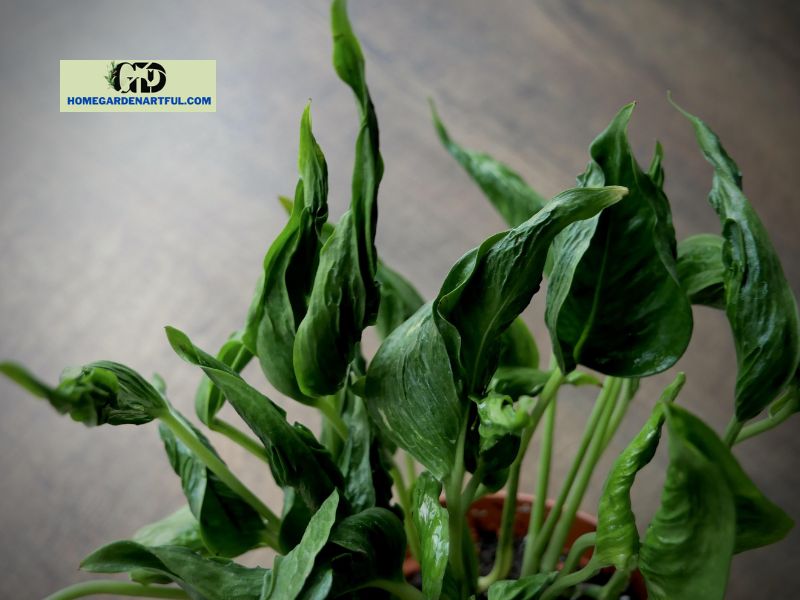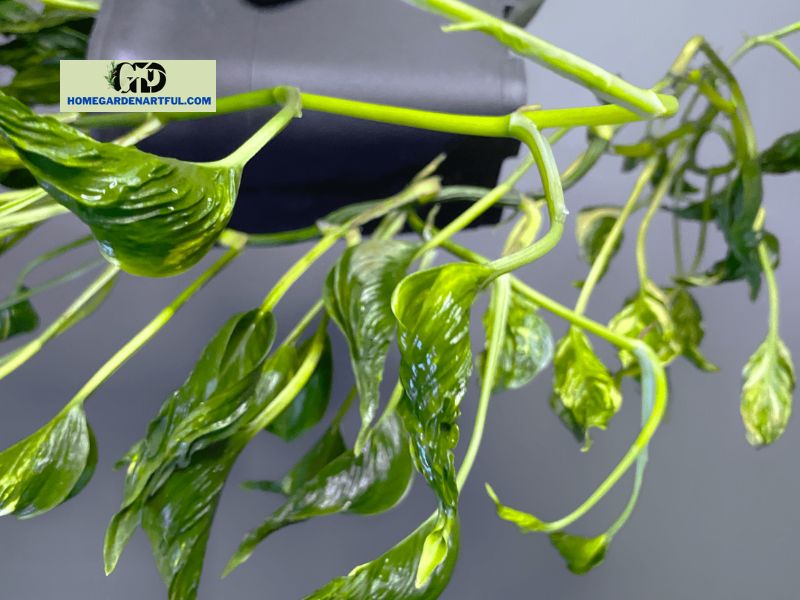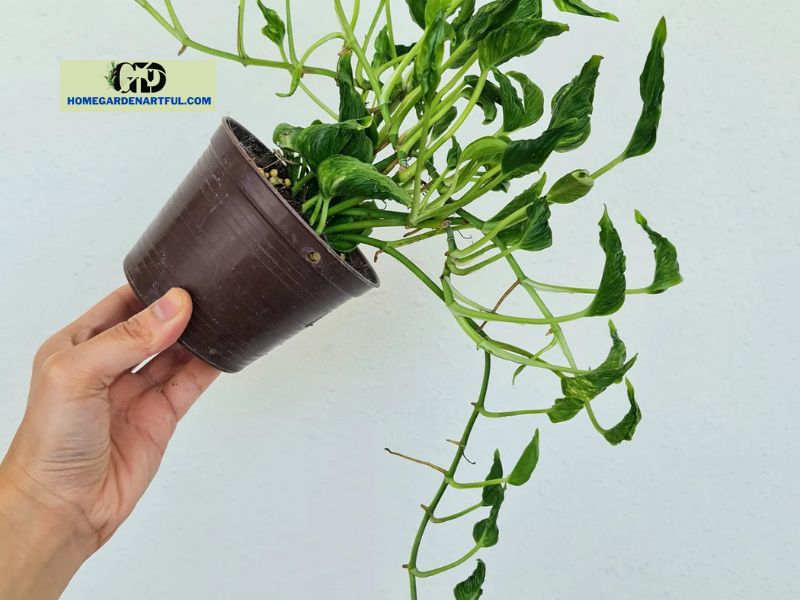Epipremnum Aureum ‘Shangri La Pothos‘, an uncommon variety of pothos, has some untamed-looking leaves. Continue reading at homegardenartful.com for a comprehensive guide to Shangri La plant propagation and care.
What is Shangri La Pothos?

A cultivar of golden pothos called Shangri La Pothos was developed. It features bright green foliage with yellow variegation, but what distinguishes it is how withered the leaves seem.
Whereas the leaves of other pothos rest flat, those of the Shangri La are wrinkled and partly folded up.
The term “spinach pothos” comes from the way the leaves resemble cooked spinach leaves. Due to the leaves’ “sleeping” appearance rather than its being fully “awake” and open, it is also known as the sleeping pothos.
Additionally, it goes by the name Godzilla Pothos. This moniker likely derives from the upward-pointing leaves, which resemble Godzilla in some ways.
It has very distinctive foliage and is an uncommon plant. It’s undoubtedly not for everyone, but in my opinion, it’s a cool plant.
How do you care for Shangri La Pothos?

The upkeep of a Shangri La Pothos plant is almost as simple as that of any other pothos. Getting the lighting perfect is the only mildly challenging aspect. Below, I’ll explain why that is.
Light
Shangri La Pothos favors mild illumination. The plant will lose variegation if the light level is too low, but if the light level is too high, the leaves will fully expand and lose their distinctive, shriveled appearance.
Bright light is necessary for variegated plants to preserve their pattern since the lighter-colored regions of their leaves don’t contain enough chlorophyll.
Consider purchasing a grow lamp if you reside in a low-light environment and desire that your plant’s variegation remain vibrant. This will ensure that you have the correct level of light for your plant.
Just keep it away from the grow light so that the sleeping pothos doesn’t fully open and instead remains asleep.
Watering
When the top 2 inches of the potting mix are dry, water your pothos. It prefers to maintain some moisture but does not prefer to be kept as moisture as other pothos plants.
Vining plants typically begin to droop when they become too dry. The Shangri La Pothos’ naturally shriveled leaves may make this a little harder to see.
Instead of relying on that, monitor the potting mix and ensure that you check its moisture content once every week or so by feeling it with your finger to determine whether your plant needs to be watered.
You should keep an eye on this because doing so will not only help you water your plant when it requires it but also prevent you from overwatering it. It’s crucial to avoid overwatering your plant. Root rot and plant mortality could result from excessive overwatering.
Potting Mix
Being so little maintenance is one of the most amazing things about pothos. This also applies to the Shangri La!
Just a well-draining potting mix will do. You only need perlite and a common indoor plant potting mix to do this. Puffed volcanic rock, or perlite, aids in aeration and improves drainage.
Since it doesn’t need to be accurate, I usually eyeball the ratio in this situation. For a small pot, use a handful or so of perlite; as the pot gets bigger, use more handfuls.
When your Shangri La Pothos becomes rootbound, report it. The frequency of this simply depends on how quickly your plant grows. Rather than following a strict schedule, look out for these symptoms of rootbound ness:
- Roots protruding from the drainage holes of the pot
- You’ll need to remove the plant from its pot to examine this, however, the interior bottom of the pot was extensively covered in roots.
- Stunted growth or a plant that appears ill (this is a good clue, but also search for one of the two symptoms mentioned above)
- Use a pot with good drainage that is one size larger when repotting. Repotting should ideally be saved for the growing seasons (spring and summer).
Fertilizing

When plants are growing (in the spring and summer), fertilize them once a month with a balanced fertilizer. Likewise, dilute the fertilizer by half.
Pothos shouldn’t be overfertilized because they don’t require it and it might harm them. Pothos plants don’t need fertilizer; it only gives them a little boost.
Temperature
Shangri La Pothos and other pothos are not particularly picky about temperature. However, try to maintain a temperature above 60 degrees Fahrenheit, as houseplants do not generally like to be chilly.
You don’t need to get to your thermostat right now! If it’s cold outside, simply move your plants away from windowsills, the front entrance, and wide windows in your house.
Humidity
The Shangri La Pothos will undoubtedly benefit from some more humidity because pothos naturally flourish in moist conditions.
Using a humidifier to accomplish this is the simplest method. I adore this technique since it requires little upkeep and, depending on the size of the humidifier, can benefit numerous plants simultaneously.
This humidifier is great because it can operate in an average-sized room for about a full day.
Climbing
The Shangri La Pothos’ natural growth habit includes climbing. It scales objects via its aerial roots.
It will develop more fully and become larger by simulating natural growth. Giving your plant a moss pole to climb will make this simple for you.
Size and Rate of Growth
Considering that it is a member of a species that is typically known for its rapid growth, Shangri La Pothos grows rather slowly. Don’t anticipate any significant growth surges, but you may encourage it to develop as quickly as it can by giving it the best humidity, lighting, and watering conditions.
In ideal circumstances, it can grow close to 10 feet tall or long, but as an indoor plant, it is unlikely to get that tall or long.


